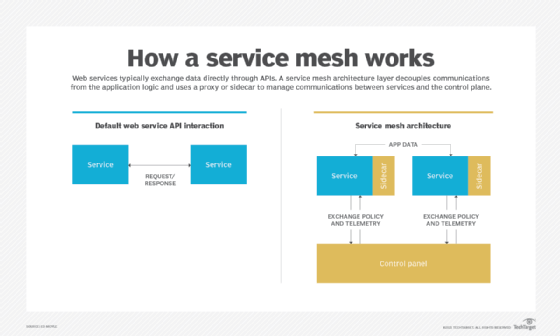Service Mesh in Kubernetes: Unveiling the Invisible Network Layer
Introduction to Service Mesh
Service Mesh is a crucial component in managing communication between services in a Kubernetes environment. It helps address the challenges developers face with microservices architecture by providing features like service discovery, load balancing, traffic routing, and observability. Service Mesh acts as a communication layer between services, allowing them to interact seamlessly while handling complexities like service discovery and routing. It does this by deploying lightweight sidecar proxies alongside each service, which handle the network traffic and provide advanced functionalities. Some popular Service Mesh solutions include Istio, Linkerd, and Consul.
By adopting Service Mesh, companies can effectively manage and secure their cloud native applications, ensuring better scalability and resilience.
Understanding Istio and its Functionality
Istio is a powerful tool that helps manage and secure microservices in Kubernetes. It acts as a service mesh, providing a layer of functionality between services in your stack. With Istio, you can easily control traffic routing, enforce policies, and implement observability features for your applications. One of the key components of Istio is the data plane, which consists of sidecar proxies that handle traffic between services. These proxies enable advanced features like circuit breaking, load balancing, and fault injection. Istio also integrates with other popular tools like Linkerd and Consul.
By understanding Istio and its functionality, you can optimize your infrastructure layer and ensure the smooth operation of your cloud native applications.

Implementation of a Service Mesh in Kubernetes
Implementing a service mesh in Kubernetes can greatly enhance the management and control of your containerized applications. By utilizing a service mesh, you can streamline communication between services, improve observability, and enhance security. There are several popular service mesh solutions available, such as Istio, Linkerd, and Consul. These tools provide features like traffic management, load balancing, and fault tolerance, making them essential for managing microservices architecture. When implementing a service mesh, it is important to consider factors such as the data plane, control plane, and mesh gateway.
By implementing a service mesh, you can simplify the management of your Kubernetes infrastructure and ensure smooth communication between services.
Preparing for Service Mesh Integration
Before integrating a service mesh into a Kubernetes environment, there are a few important steps to take. First, ensure that the necessary Linux training has been completed to understand the underlying infrastructure. This will help optimize the outcome of the integration process. Next, familiarize yourself with the different components and standards involved, such as container orchestration and microservices architecture. Additionally, consider the challenges that developers may face, such as tracking services and managing application containers. By preparing for service mesh integration, companies can navigate the complexities of the application layer and ensure a smooth transition into a more efficient and secure infrastructure.
Benefits and Capabilities of a Service Mesh
A service mesh provides numerous benefits and capabilities for managing microservices in a Kubernetes environment. It helps in solving challenges faced by developers, such as service discovery, load balancing, and traffic management. By acting as a dedicated infrastructure layer, a service mesh enables better observability and control over the traffic flowing between microservices. It also offers features like circuit breaking, retries, and timeouts to improve the reliability and resilience of applications. With its ability to handle encryption and authentication, a service mesh enhances security in a distributed system.
Comparing Service Mesh Options for Kubernetes
Understanding Service Mesh in Kubernetes
| Service Mesh | Features | Supported Kubernetes Platforms | Community Support | Documentation |
|---|---|---|---|---|
| Linkerd | Automatic mTLS, Observability, Load Balancing, Circuit Breaking, Traffic Splitting | Kubernetes, OpenShift | Active community | Extensive documentation and guides |
| Istio | Automatic mTLS, Observability, Load Balancing, Circuit Breaking, Traffic Splitting, Request Routing, Fault Injection, Rate Limiting | Kubernetes, OpenShift, Consul, Nomad, EKS, GKE, AKS, and more | Large community with multiple contributors | Comprehensive documentation and examples |
| Consul Connect | Automatic mTLS, Service Discovery, Load Balancing, Traffic Splitting, Health Checks | Kubernetes, OpenShift, Consul | Active community and HashiCorp support | Well-documented with tutorials and guides |
| Kuma | Automatic mTLS, Observability, Load Balancing, Traffic Routing, Traffic Policies | Kubernetes, OpenShift, EKS, GKE, AKS, and more | Growing community and support from Kong | Clear documentation and getting started guides |
Migration between Service Mesh Solutions
One key consideration is the compatibility between the old and new solutions. It is essential to ensure that the new solution is able to meet the specific needs of the application or stack. This may involve understanding the different components and standards used by each solution, and making any necessary adjustments or configurations.
Another important aspect to consider is the impact on the application layer. Migration between Service Mesh Solutions may affect the way applications communicate with each other. It is crucial to understand the path and flow of traffic within the mesh, and make any necessary changes to ensure uninterrupted communication.
Additionally, the migration process may involve considerations such as container orchestration and networking. It is important to evaluate how the new solution integrates with the existing infrastructure and networking components, such as Kubernetes or VMWare NSX.
The Evolution and Future of Service Mesh Technology
Service mesh technology has rapidly evolved over the years and holds immense potential for the future. In the realm of Kubernetes, understanding service mesh is crucial for developers and operators alike. Service mesh acts as a standardized layer for handling communication between services, ensuring reliability and security. It eliminates the need for manual coding, reducing complexity and allowing developers to focus on other aspects of their applications. With the rise of containers and microservices architecture, service mesh technology has become indispensable in managing the intricate web of inter-service communication. By leveraging features like micro-proxies and mesh gateways, developers can easily track and manage service-to-service requests, providing a seamless experience for end-users.
As cloud-native applications continue to take center stage, service mesh technology will play a vital role in simplifying the operation of these complex environments.


